Very strong and shallow M7.2 earthquake hits Oaxaca, Mexico
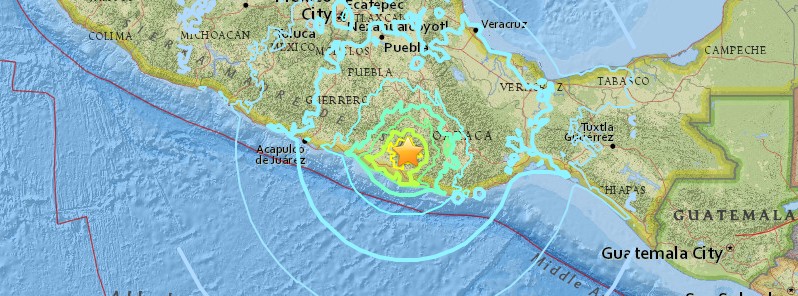
A very strong and shallow earthquake registered by the USGS as M7.2 hit Oaxaca, Mexico at 23:39 UTC (17:39 local time) on February 16, 2018. The agency is reporting a depth of 24.7 km (15.3 miles). EMSC is reporting M7.2 at a depth of 10 km (6.2 miles). Mexico's SSN is reporting M7.2 at a depth of 12 km (7.4 miles). A yellow alert was issued for shaking-related fatalities and economic losses.
According to the USGS, the epicenter was located 31.6 km (19.7 miles) NNE of San Agustín Chayuco (population 0), 54.5 km (33.9 miles) NE of Pinotepa Nacional (population 25 669), 69 km (42.9 miles) S of Heroica Ciudad de Tlaxiaco (population 14 608), and 80.7 km (50.1 miles) E of Ometepec (population 17 801), Mexico.
There are 1 100 000 people living within 100 km (62 miles) and 11 000 within 10 km.
16 000 people are estimated to have felt very strong shaking, 439 000 strong, 1 322 000 moderate and 34 449 000 weak.
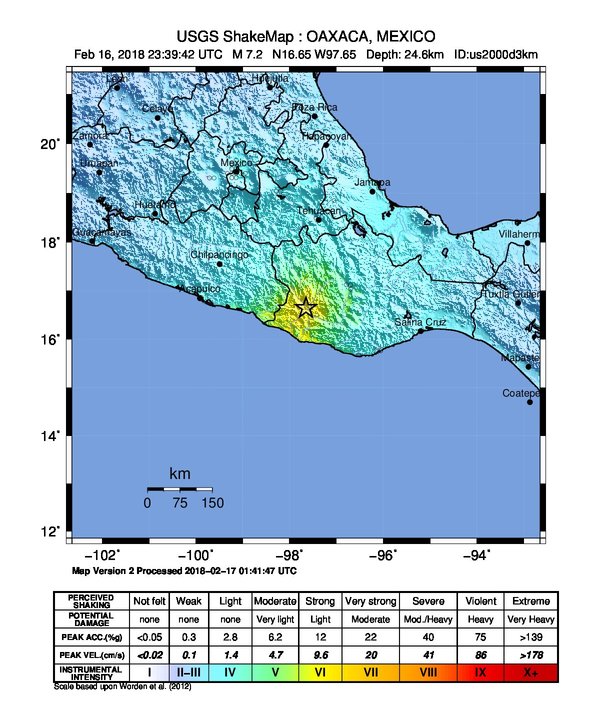 The USGS issued a yellow alert for shaking-related fatalities and economic losses. Some casualties and damage are possible and the impact should be relatively localized. Past yellow alerts have required a local or regional level response.
The USGS issued a yellow alert for shaking-related fatalities and economic losses. Some casualties and damage are possible and the impact should be relatively localized. Past yellow alerts have required a local or regional level response.
Estimated economic losses are less than 1% of GDP of Mexico.
Overall, the population in this region resides in structures that are a mix of vulnerable and earthquake resistant construction. The predominant vulnerable building types are mud wall and adobe block with concrete bond beam construction.
Recent earthquakes in this area have caused secondary hazards such as tsunamis and landslides that might have contributed to losses.
Updates
At 02:01 UTC, the Governor of Oaxaca said there are no reports of people killed. "However, places like National Pinotepa, Río Grande, Jamiltepec and San José del Progreso report damage in dozens of buildings."
El gobernador de Oaxaca México @alejandromurat afirma que no existen hasta el momento reporte de personas fallecidas por sismo. Sin embargo lugares como Pinotepa Nacional, Río Grande, Jamiltepec y San José del Progreso reportan daños en decenas de inmuebles. pic.twitter.com/VvY9zuLnj1
— Francisco Elvira (@PacoElviraMX) February 17, 2018
#Sismo de magnitud 7,2 que se percibió en los estados de Oaxaca (sur), Chiapas (sureste), Puebla (centro), Michoacán (oeste), y en la Ciudad de México, no deja daños humanos ni materiales hasta el momento pic.twitter.com/zbFlLqEsrd
— Class 98.7FM (@Class987FM) February 17, 2018
Así fueron los daños reportados en Pinotepa Nacional, Oaxaca, lugar del epicentro del sismo de 7.2 grados que también se sintió en Veracruz #AlMomento pic.twitter.com/bgupoNinut
— Francisco Elvira (@PacoElviraMX) February 17, 2018
Estimated population exposure to earthquake shaking
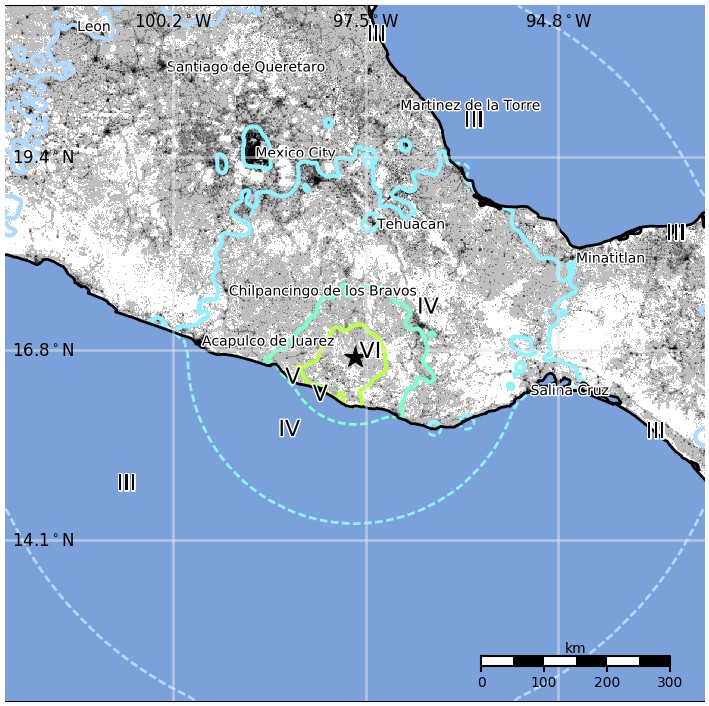
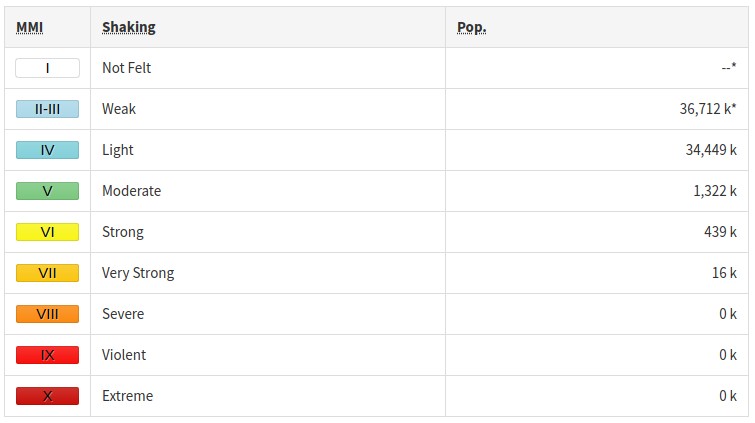
Selected cities exposed
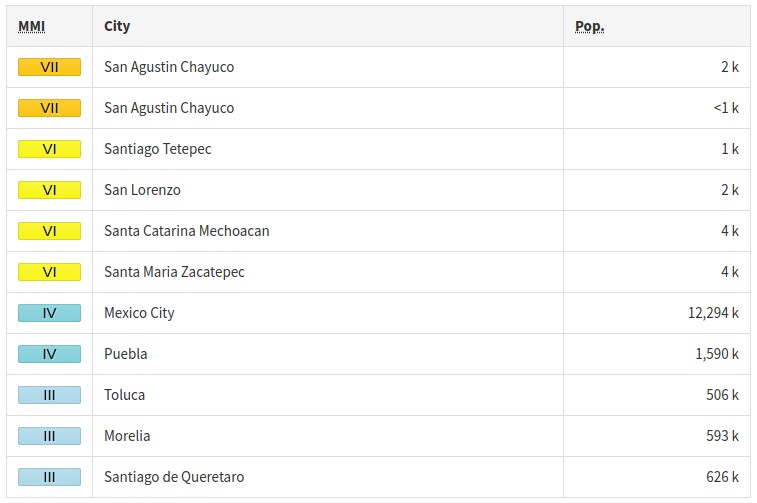
Regional seismicity

Seismotectonics of Mexico
Located atop three of the large tectonic plates, Mexico is one of the world's most seismically active regions. The relative motion of these crustal plates causes frequent earthquakes and occasional volcanic eruptions. Most of the Mexican landmass is on the westward moving North American plate. The Pacific Ocean floor south of Mexico is being carried northeastward by the underlying Cocos plate. Because oceanic crust is relatively dense, when the Pacific Ocean floor encounters the lighter continental crust of the Mexican landmass, the ocean floor is subducted beneath the North American plate creating the deep Middle American trench along Mexico's southern coast. Also as a result of this convergence, the westward moving Mexico landmass is slowed and crumpled creating the mountain ranges of southern Mexico and earthquakes near Mexico's southern coast. As the oceanic crust is pulled downward, it melts; the molten material is then forced upward through weaknesses in the overlying continental crust. This process has created a region of volcanoes across south-central Mexico known as the Cordillera Neovolcánica.
The area west of the Gulf of California, including Mexico's Baja California Peninsula, is moving northwestward with the Pacific plate at about 50 mm per year. Here, the Pacific and North American plates grind past each other creating strike-slip faulting, the southern extension of California's San Andreas fault. In the past, this relative plate motion pulled Baja California away from the coast forming the Gulf of California and is the cause of earthquakes in the Gulf of California region today.
Mexico has a long history of destructive earthquakes and volcanic eruptions. In September 1985, a magnitude 8.0 earthquake killed more than 9,500 people in Mexico City. In southern Mexico, Volcán de Colima and El Chichón erupted in 2005 and 1982, respectively. Paricutín volcano, west of Mexico City, began venting smoke in a cornfield in 1943; a decade later this new volcano had grown to a height of 424 meters. Popocatépetl and Ixtaccíhuatl volcanos ("smoking mountain" and "white lady", respectively), southeast of Mexico City, occasionally vent gas that can be clearly seen from the City, a reminder that volcanic activity is ongoing. In 1994 and 2000 Popocatépetl renewed its activity forcing the evacuation of nearby towns, causing seismologists and government officials to be concerned about the effect a large-scale eruption might have on the heavily populated region. Popocatépetl volcano last erupted in 2010. (USGS)
Featured image credit: USGS

Great coverage! I’m glad I discovered this site at last! I’ll check on what you’re reporting every day from now on. I already follow you on Twitter, and that information is helpful, too.
Welcome!
Never came out to be wrong when I stated that strong or major earthquake will take place after certain solar events. See the facebook of the Helical Universe. https://www.facebook.com/Helicaluniverse/
I do not possess a divine power, but I understand the physical reality of our star and its true relation with our planet. I am an honest and truthful scientist in the era of widespread pseudo physics theories and notions. You are sitting comfortably in your ivory towers and creating unlimited number of myths and pseudo physics theories so you can collect billions and billions from taxpayers’ money. Since the beginning of the 20th century, physics has entered a dark age and it is getting darker every day.